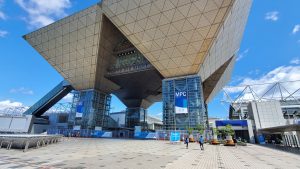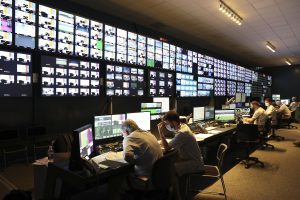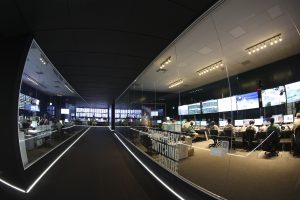Live From Tokyo Olympics: OBS Technical Area Offers Inside Look at How The Games Come Together
One of the highlights of a visit to an Olympics IBC is getting a chance to see the team at work in the technical area. Any time of day there will be at least some activity going on and watching the amount of work being done lower and rise based on the tide of incoming events is always fascinating. Here’s a quick tour of this year’s facilities:

Tokyo Big Sight, the largest exhibition center in Japan, is home to the IBC and MPC for the Tokyo Olympics.
Contribution, Distribution & Unilateral
One of the areas that always impresses is the contribution, distribution, and unilateral area. But this year, more than ever sees the facility transitioning as it involves an extensive combination of on-premises broadcast and IT components, both physical and virtualized, and fully virtualised systems placed on specially managed public cloud. The OBS technical infrastructure is also based more and more on IP technologies, taking full advantage of the flexibility and increased reliability that can be engineered based on virtualized and cloud-centric architectures.
The contribution, distribution, and unilateral area brings everything together from the venues and beyond. The efforts are the basis for a production that sees OBS broadcast all outputs in UHD, combined with HDR and immersive audio from the 42 Olympic competition venues (only the production for the seven outside Tennis courts will remain in HD).

The OBS tech area is at the center of OBS Olympic production and distribution.
All RHBs receive the international signal in HD, based on the host city’s HD standards. For Tokyo, the SMPTE 292 standard is used for the production of the 1080i/59.94 HD-SDI signal. OBS will follow the 59.94 Hz specification. UHD takers will receive the international signal in UHD HDR, with 5.1.4 audio configuration. The UHD production adheres to the SMPTE 2036-1 standard and follow the 59.94 Hz specification. The HDR standard is Hybrid-Log Gamma (HLG) with WCG (Wider Color Gamut) following the BT-2100-2 and BT.2020 ITU standards, respectively.
As per the rights agreements and relevant IOC technical manuals, the ITVR signals are produced and delivered in High Definition at the aspect ratio of 16:9 with discrete 5.1 surround sound, as well as in stereo sound for television and in stereo for radio.
While accomplishing the above obligation for all RHBs, OBS will also produce Ultra High Definition (UHD) – also referred to as 4K UHDTV – coverage of all sports, the Opening and Closing Ceremonies, and the beauty cameras of the Olympic Games. The full live 4K coverage of the Olympic Games comes also with the adoption of HDR (High Dynamic Range).
The UHD coverage is an exact copy of the OBS coverage in HD, since it is derived from the same cameras and follows the same direction sequences with HD.
Audio
OBS is capturing the sounds of the Tokyo 2020 Olympics through an immersive 5.1.4 audio configuration that enables viewers to have a more realistic audio experience, with sound appearing to come from every direction – even from above.
OBS has expanded upon 5.1 surround sound by adding an overhead, and thus third dimension with the addition of four hanging ceiling microphones with heights that will be adjustable. Two new microphones were specifically designed for this immersive sound production. In total, OBS will use 3,600 microphones (28 different models). Three immersive audio quality control rooms will support the venue production and guarantee quality consistency across all sports.
The CDU hosts four audio monitoring rooms, including two that are fully equipped to monitor surround sound in 5.1.4 and two others which may be used for ongoing monitoring of any issue that risks tying up the main rooms for an extended period.
The operators work closely with Contribution operators in CDU while performing the daily line-up procedures of the Multilaterals from the venues. They also continually monitor the surround sound quality for all Multilaterals and other sources during competition.
Commentary Switching Center

The OBS commentary and international transmission MCR at the Tokyo Games.
The global audience for the games means they are broadcast in a vast number of languages which, in turn, makes the commentary switching center as crucial as it gets. Multilateral and unilateral commentary and coordination audio circuits from the venues and the IBC are routed through the Commentary Switching Center (CSC). The testing, monitoring and troubleshooting of these signals is the responsibility of the CSC, in cooperation with the Commentary Control Room (CCR) at the venues. All commentary and coordination signals from Games-time bookable facilities in the IBC and the venues also pass through the Transmission Centre before being delivered to the RHB areas.
For the commentary and coordination audio, the same fully redundant contribution network used for the data and video feeds, is used to provide an end-to-end transport and establish full-duplex communication between the competition venues and the IBC. OBS provides, installs and operates all required equipment (commentary units, network transmission and switching/routing equipment, digital-analogue panels, network management, etc.) The service is supported at the venue from the Commentary Control Room (CCR), and in the Commentary Switching Centre (CSC) in the IBC. At the venues, all RHB commentary and coordination circuit extensions from the RHB unilateral positions (compound, mixed zone, announce and camera platforms) will be connected to/via the CCR by OBS. All RHB ordered and confirmed bi-directional audio circuits between venues and the IBC will terminate at the OBS/RHB demarcation points.
For the first time, CSC is also providing the possibility of sending remotely coordination circuits all the way from the venue, through CSC and out through internet, to RHBs facilities back home. This service will be expanded in Beijing 2022 with actual commentary circuits and delivery of Radio Package remotely.
The left most positions in the main console are the operators for Occasional Services. They switch and monitor the coordination circuits and commentary audio from the Games Time bookable services. The center positions are the CSC Operators, who monitor and supervise the commentary audio from the venue commentary positions. The right most positions take care of the commentary audio coming from the IBC Off-tubes.
Archive
Located in the OBS Tech area, the Archive Department is responsible for recording more than 9,500 hours on the Media Server: all of the HD and UHD feeds produced by OBS and received at the IBC from the various venues all around Tokyo and Japan. Simply put, the Archive Team ensures that the Olympic legacy is preserved for posterity.
The OBS Media Server is accessible remotely through the service of the CONTENT+ platform. Designed primarily for digital use by the RHBs’ digital and social media teams, the platform is accessible worldwide so users can select footage and have it transferred digitally to their local production units.
The Archive Team is also responsible for file transferring the content recorded throughout the Olympic Games to the headquarters of the International Olympic Committee in Lausanne, Switzerland for heritage and legacy purposes.
